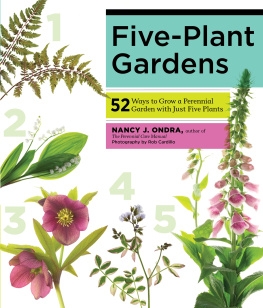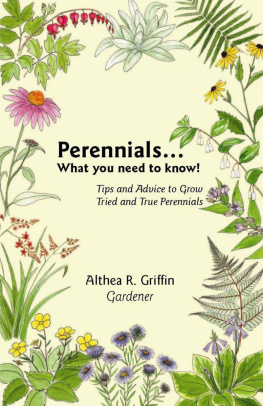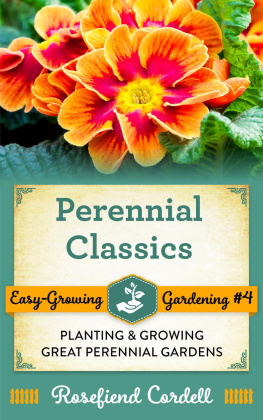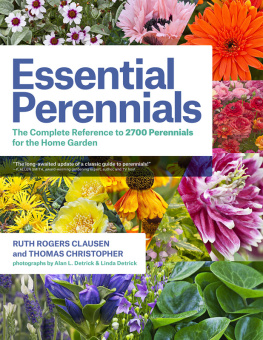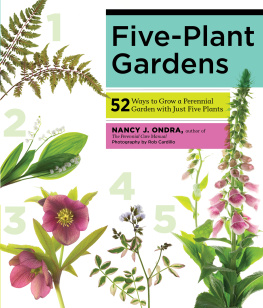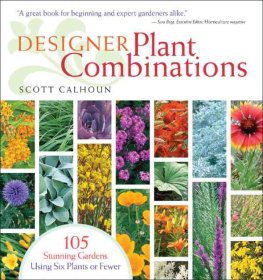


CONTENTS

WELCOME TO THE PERENNIAL MATCHMAKER!
I snt it fascinating how two people can start with the same things and end up with very different results? One person can turn basic ingredients into an unforgettable meal or turn thrift-shop finds into an eye-catching outfit, while another ends up with something barely edible or barely wearable. Its the same with perennials: Two gardeners can shop at the same garden center, but one turns those plants into a gorgeous perennial border and the other simply has a random collection of flowers. Sure, some people can transform the ordinary into the extraordinary just on instinct, but the rest of us need to hone our garden design skillsby learning the basics, taking inspiration from others, and bringing it all together to make our own gardens look amazing. And thats where The Perennial Matchmaker comes in.
Whether youre just starting with perennials or are a longtime gardener who wants to fine-tune your plantings for a more cohesive look, The Perennial Matchmaker will be your go-to guide for creating stunning plant medleys. And this matchmaker angle is easy to understandits a favorite perennial looking for friends!
Are you ready to choose co-stars for perennials that are already in your yard or that youve been longing to plant? Finding the perfect partner starts with identifying one key feature you want to play up on your focus plant, then sorting through possibilities for contrast until you come up with complementary partners. Look up your favorite plants in . This encyclopedia of more than 80 popular perennials features photos of simple yet striking perennial partnerships that you can use right away, as well as lots of ideas for crafting other eye-catching color combinations, dramatic textural displays, and stunning seasonal effects with compatible perennial companions. Each entry also includes a quick-reference list of Bloom Buddies, so you can see at a glance which other perennials are likely to flower at the same time: a huge help if youre trying to plan a spectacular flower garden.
Would you prefer to create your own combinations from scratch? , delves into the thought process behind those breathtaking perennial pairings. Youll learn how to really look at a perennialnot just the color of its flowers, but also the shape and size of its blooms and leaves, its special features in each season, and so onand how to figure out where it wants to grow. Once you can do that, youll narrow the pool of countless potential partners down to a manageable handful, making it easy to find perfect matches for any perennial, whether you have room for just two or three plants or want to build a whole border.
This how-to guide also includes the scoop on finding design inspiration, working with color, adding seasonal interest, and expanding your plant palette way beyond perennials. Youll learn how to take care of your combinations, too, so your garden will always look its very best.
Ive been working with plants since I was a teenager, and over the last several decades Ive immersed myself in all things green and colorful and beautiful. In my own gardens and those of others, Ive planted and maintained beds and borders in a variety of sites and settings, and Ive seen countless amazing plant combinations: Some I made on purpose or by luck, and many other surprising and delightful pairings the plants made on their own. Inspired by this firsthand experience, as well as actual and virtual visits to perennial gardens all over the world, Im thrilled to have this opportunity to share with you what Ive learned about creating breathtaking perennial partnerships. Its my hope that The Perennial Matchmaker will become your go-to guide when youre ready to turn your perennial dream garden into a glorious reality. Happy matching!
Nancy J. Ondra

Nans Top 10 Favorite Perennial Pairings
When I first started making plant combinations, I focused on color, and I still enjoy making high-contrast pairings: particularly bright flowers with dark foliage. Over the years, though, Ive come to appreciate more subtle matches, too: similar colors with different flower forms, for instance, or foliage-with-foliage combos. Below are some of my most favorite matches to date. I cant wait to see what new combinations I can come up with this year!

Kobold spike blazing star (Liatris spicata) with drumstick allium (Allium sphaerocephalon). These two flowers are similar color-wise, but their flower forms are distinctly different, providing much-needed visual variety. To be honest, I didnt plant these two together on purpose, but I love the results. This combo peaks in midsummer but looks good well into fall, thanks to the interesting seed heads.

Karl Foerster feather reed grass (Calamagrostisacutiflora) with pink muhly grass (Muhlenbergia capillaris). One of the first bits of advice I ever got from a gardening expert was to avoid planting grasses with grasses. Since then, Ive taken it as a personal challenge to come up with interesting combinations and even whole borders based mostly or completely on ornamental grasses. This simple pairing along my driveway has been one of my favorites for several years. The pink muhly grass blends into the base of the feather reed grass for most of the growing season, but in fall, it explodes into a froth of misty pink flowers.

Variegated sweet iris (Iris pallida Variegata) with Axminster Gold Russian comfrey (Symphytumuplandicum) and ladys mantle (Alchemilla mollis). This trio breaks another rule: Dont plant two variegated plants next to each other. Yes, the effect can look too busy, but I think this one works because the color range is rather limited. It also helps that there are different leaf and plant forms. Axminster Gold Russian comfrey can be hard to find, but its worth tracking down. Or consider a medium-size, yellow-variegated hosta instead, such as Earth Angel or Great Expectations.

Sun Power hosta with Japanese blood grass (Imperata cylindrica Rubra). I normally wouldnt combine bright yellow with bright red without including something dark as well, but I really enjoy this strong contrast of color and form, and it looks great from early summer to frost. Because of the concerns about this grass becoming invasive, though, Im thinking of replacing it with Beni-kaze Hakone grass (


